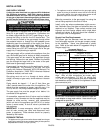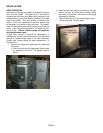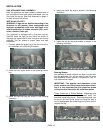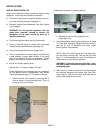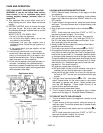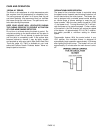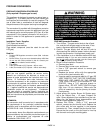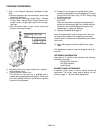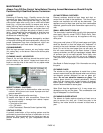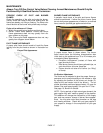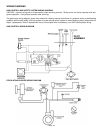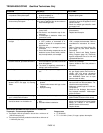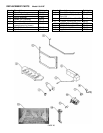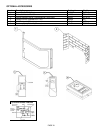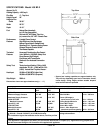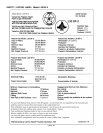
MAINTENANCE
Always Turn Off Gas Control Valve Before Cleaning. Annual Maintenance Should Only Be
Performed By A Qualified Service Technician:
PAGE 16
LOG SET
Removing & Cleaning Logs - Carefully remove the logs
(removing top logs, then lifting front log out, then rear
log). Use care when handling the fiber logs, as they be-
come quite fragile after curing. Use a small soft-bristled
brush (e.g., a nylon paint brush) to remove soot, dust or
debris that may have accumulated on the burner or log
set. Remove the logs and burner, and clean them out-
side the home in a location with plenty of fresh air venti-
lation. Avoid breathing fine particulates of dust that may
be generated. See page 10, Installing Log Set for in-
structions on reinstalling logs.
Replacing Logs - If logs become damaged by accident
or improper handling and need replacement, use only the
proper replacement logs from manufacturer, which can
be purchased from your local dealer. See page 20.
CLEANING BURNER
With the logs removed, vacuum out any foreign matter
(lint, carbon etc.) on the burner. Be sure the burner ports
are “open.”
CLEANING VALVE / AIR VENTURI
Clean all lint and dust build-up around the control valve
and air shutter on the venturi. Inspect and clean with a
brush or wire the inlet of the venturi for any spider webs
or lint accumulation.
INSPECT WIRING / CAUTIONS:
1) Label all wires prior to disconnection when servicing
controls. Wiring errors can cause improper and dan-
gerous operation.
2) Verify proper operation after servicing.
3) Inspect and clean all wire connections. Ensure that
there is no melting or damage from rodents. Inspec-
tion should include:
• Terminals at the valve
• On / Off switch
• Wall Thermostat / Remote Control (optional kits)
VENTING SYSTEM
A periodic examination of the venting system must be
performed to ensure that the flow of combustion air is not
obstructed. We recommend that you have your gas ap-
pliance checked yearly by your independent Lennox
dealer.
CLEAN EXTERNAL SURFACES
External surfaces should be kept clean and dust re-
moved form air inlets to the appliance. The flow of com-
bustion and ventilation air must not be obstructed. The
appliance must be kept clear and free from combustible
materials, gasoline and other flammable vapors and liq-
uids.
SMALL AREA PAINT TOUCH-UP
The stove body is painted with a quality high-temperature
stove paint. Use only model TSPK-C Stove Paint, Cata-
log # 19L92. Do not touch-up this appliance with any
other paint.
Using one small piece of 320 grit sand paper and lightly
sand the blemish so that the edges are “feathered” or
smooth to the touch between the painted and bare sur-
faces. Do not let the sand paper gum up with paint, as
this will cause scratches on the metal surface. If there
are any scratches, use 600 grit sandpaper instead. Mask
off surfaces you do not want painted. Paint lightly over
the bare surface first as this will act as an undercoat.
Then paint over a larger area in smooth even strokes to
blend.
See Break-In Period on page 13 for information on curing
the paint.
CLEANING GLASS
The window on the gas appliance is made from a clear
ceramic material and may be cleaned when cool with any
non-abrasive product designed for use on glass win-
dows. Do not use abrasive cleaners on glass. The
viewing glass should be cleaned periodically. Exterior
glass may be cleaned with a glass cleaner as desired.
Interior glass - use soap and water, or commercial glass
cleaner recommended for stove glass.
Note: Each time the appliance is lit, it may cause con-
densation and fog on the glass. This condensation and
fog will disappear in a few minutes.
CLEANING BLOWER INTAKE
The blower air intake requires cleaning at least once a
year to remove lint, dust, etc. If there are pets in the
dwelling, the intake should be cleaned at least twice a
year.



